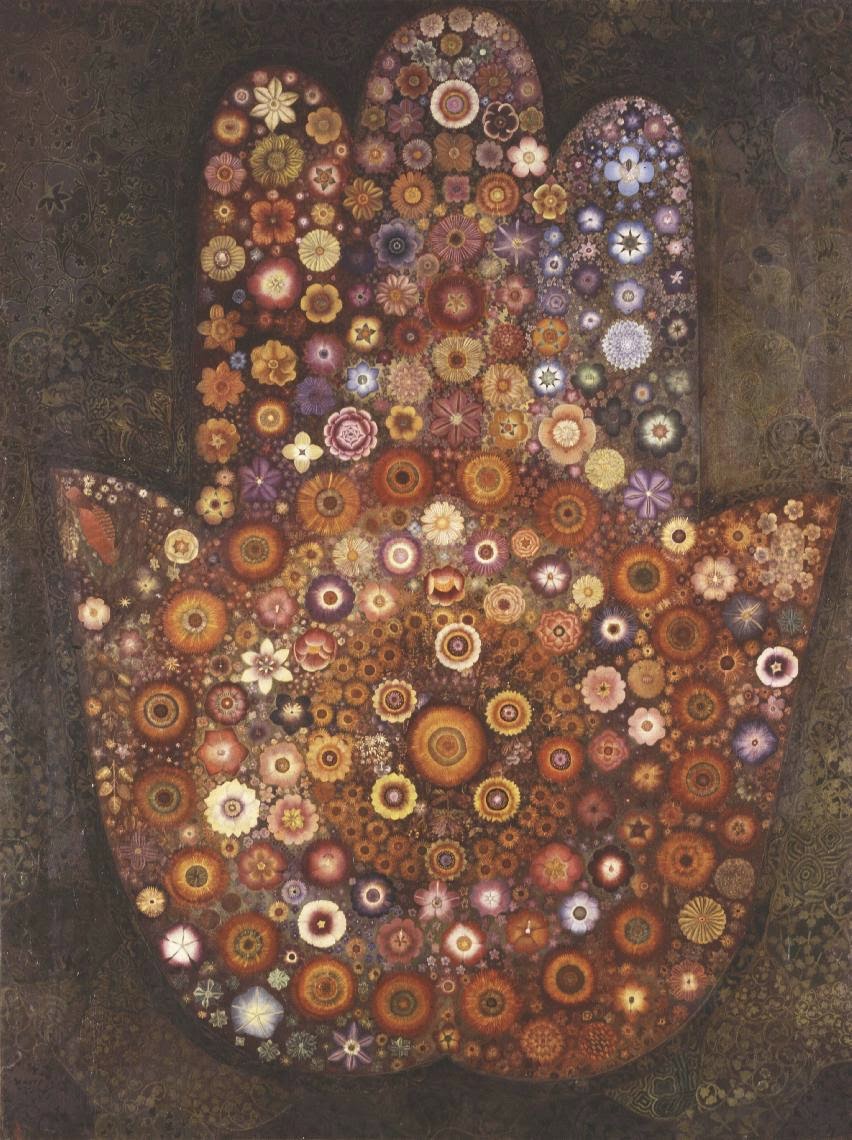I
have been coming across this particular symbol at too many places and at too many times
that its kind of mysterious. Had to know the logic behind me seeing it all the time. And was absolutely amazed at what I read. Surprisingly this symbol has been a favourite with countless artists and designers thereupon used on clothes, as tattoos, painting, fashion accessory and wall hangings to name a few.
So lets find out little more about this captivating symbol.
Panja
or Hamsa is the
hand of Prophet Muhammad's daughter Fatima. It is the
symbol of patience, loyalty, faith and resistance against
difficulties. According to common belief, it tells of the Fatima's
struggle for dignity and her tough life. Thereby, purity, goodness
and truth are blessed.
For
centuries, Fatima’s Hand has been a powerful talisman for good luck
and one of the most popular amulets in the world of Islam for
protection. It is hung on the walls of the house as engraving in
silver or gold or it is painted in red. It is believed that a house
protected by the Hand of Fatima will not catch fire.
In
Egypt, Morocco and Tunisia, ornaments of Fatima’s hand have the
same meaning as evil eyes. In these countries, the miracle of the
hand is given a great deal of importance.
Prophet
Muhammad takes under his aba (strong coarse wool cloth) the Hazrat
Fatima, Hazrat Ali and their sons Hasan and Hussein and then said
‘’my God, they are my family (ahl al-bayt), protect them from
evil and keep them away from bad thoughts.’’
Therefore,
the other name of Hamsa is Pençe-i Al-i Aba.
According
to traditional Islamic culture, the five fingers of Hamsa represent
the five requirements of Islam, which are-
To
profess your faith,
Pray,
Give
Alms,
To
Fast,
To
undertake a Pilgrimage to Mecca
The
five fingers of Hamsa also represent the prophet's family (ahl
al-bayt). Prophet Muhammad represented by the thumb, Ali by
forefinger, Fatima by middle finger, Hasan by ring finger and Hussein
by the little finger.
FATIMA: She
was not an ordinary woman. She was Prophet Muhammad's daughter and
Hazrat Ali's wife. It is a strong woman that continued the generation
of the Prophet Muhammad in patriarchal Arab society.
She
was the master of the healers and treated the Prophet Muhammad when
he was wounded in war. It is still believed that it is possible to
cure incurable diseases with the help of Fatima’s hand and the
prayer from the heart.
Muhammad
called his daughter Fatima his heart, soul and conscience as it was
her who continued the generation for him.
Fatima's
life became very difficult with the death of the Prophet Muhammad.
She died three months after him and was secretly buried by her
husband Hazrat Ali. The death of Fatima marked the beginning of the
bad days for Muhammad’s family.
Fatima’s
husband Ali was killed in an ambush and their sons Hasan and Hussein
were killed with their families.
The
death of Prophet Muhammad's family caused a huge indignation in the
world of Islam and launched many conflicts and separations of the
faith. It laid the foundation of different sects.
Fatima
is very important for both Sunnis and Shiites, the two major sects of
Islam. Sufis usually had the form of Hamsa (Fatima’s Hand) on the
head of their wands with the names of twelve imams and the Prophet
Ali engraved onto it. Shiism and Alawism in Anatolia are heterodox
beliefs that arose following the death of the Prophet Muhammad's
family and Fatima's hand has a great value for Schism and Alawism,
because it symbolises the ahl al bayt.
Therefore,
Fatima has a very important place in the Islamic faith, which is a
surprising symbol of sublimation to women, and her value in a
patriarchal society. The authority of goddess, which has been
attributed to the Virgin Mary in Christianity, has been given to
Fatima in Islam. The hand of Fatima is the goddess's hand and she is
still affectionately considered as a myth within a wide geographical
area.






































